Performance Data
Several different trials and much data has been acquired for the N-Virodredge™ scallop system and this document is to bring together all the data with explanations for the results. Data acquired so far is;
| 1. | Fuel used by scallop vessel | 21% reduction | |
| 2. | Damage to seabed | reduction | |
| 3. | Scallop catch rate | increase | |
| 4. | Damage rate of scallops caught | reduction |
Description of trials:
Land based drag trials;
Two complete scallop dredges – one traditional and one N-Virodredge™ – were taken to farmland and dragged behind a tractor on ground of stones/gravel/mud and on grass.
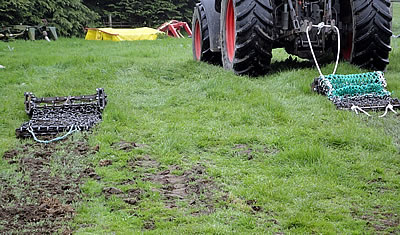 |
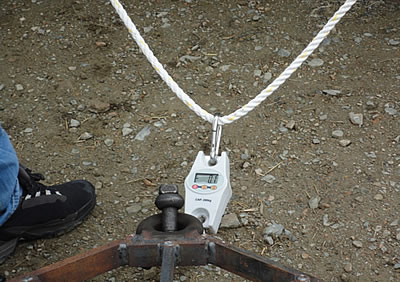 |
Each dredge was towed behind the tractor via a rope and a set of scales
Readings were taken from the scales to measure the pull in kilograms required to pull each dredge at a speed of 4mph. This data can then be used to calculate fuel usage.
The damage to the ground caused by each dredge can be assessed to give an idea of what is likely to occur on the seabed.
Fuel Consumption data
The pull/effort required to drag a traditional scallop dredge along a stoney/gravelly/muddy field at 4mph is 220kg.
The pull/effort required to drag an N-Virodredge™ scallop dredge along a stoney/gravelly/muddy field at 4mph is 125kg.
This represents a 95kg or 43% reduction in effort.
The British Scallop fleet amounts to some 200 vessels and it is estimated that the average size is 16 metres, with 8 dredges aside. This type of vessel would require around 400hp to power her and she would have a maximum bollard pull of about 5 tonnes. Additionally she would tow her dredges when fishing at about 1400rpm engine speed and would use around 4000 litres of fuel per week.
Therefore 16 dredges at 220kg each equals a total effort of 3.52 tonnes adding to that the additional gear of towbars, bridles and wires it would be reasonable to assume a total pull of 4 tonnes would be required and this would be roughly equivalent to a 400hp vessel with a bollard pull of 5 tonnes at 1800 rpm towing two sets of 8 aside scallop dredges of some 4 tonnes of drag at 1400 rpm. Therefore we need to find the engines revolutions for a reduction in bollard pull of 43% of 3.52 tonnes (or 1.5 tonnes) = 2 tonnes + extra gear = total bollard pull required of 2.5t or 37.5% less.
A typical engine type used in many 16m scallop vessels is a Caterpillar 3306 marine engine. This model of engine produces prop demand horse power of 400 @ 1800rpm and 188 @ 1400rpm. Therefore a reduction in required bollard pull of 1.5 tonnes or 37.5% would equate to a prop demand horsepower of 118 which equals a towing RPM of 1200rpm. This engine also uses 9.7 litres/hr of fuel @ 1400rpm and 6.3 litres/hr @ 1000. This represents a saving of 35%.
If it is considered that this typical/average scallop vessel tows her gear for 60% of the time she spends at sea and uses 4000 litres each full week, she will save some 840 litres per full week fishing.
|
Or |
|
average vessel |
|
840 ltr / week |
|
Or |
|
average vessel |
|
33,600 ltr / year (40wks) |
|
Or |
|
British fleet (200 vessels) |
6,720,000 ltr / year |
Seabed damage
The two types of dredge – traditional and N-Virodredge™ - were dragged along a field with a 80kg weight on top, to represent the catch, consisting of a stoney/gravelly/muddy type which then became grass. This type of ground was judged to best represent the type of seabed most likely to suffer damage from scallop fishing.
First towed was the traditional dredge:
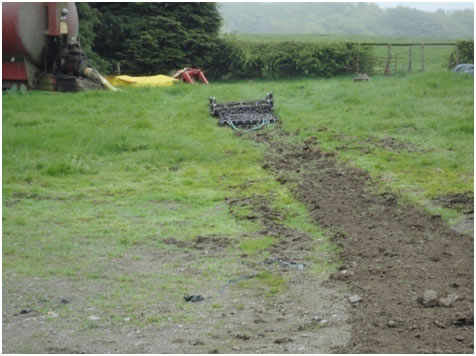 |
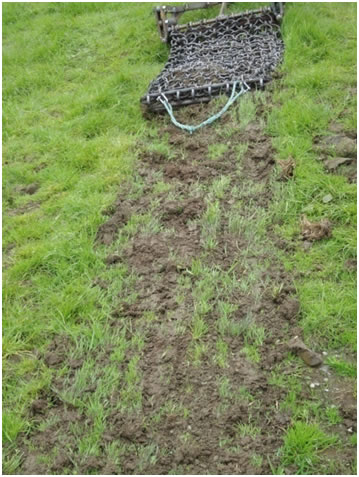 |
Next came the N-Virodredge™;
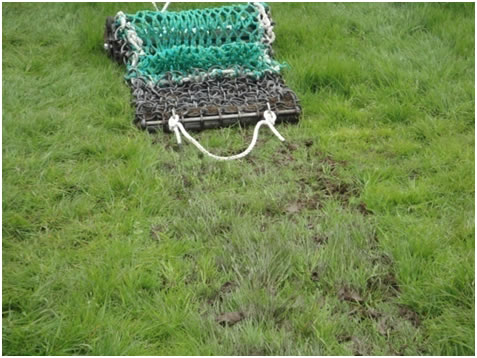 |
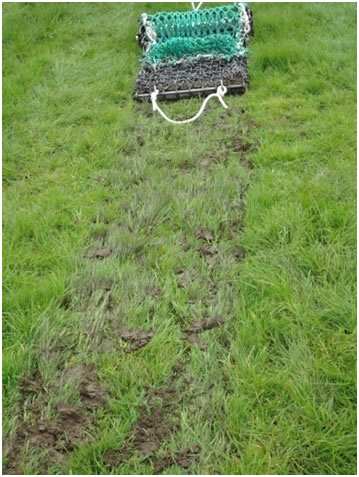 |
| Closer inspection of the damage was observed for the Traditional dredge; |
And for the N-Virodredge™; |
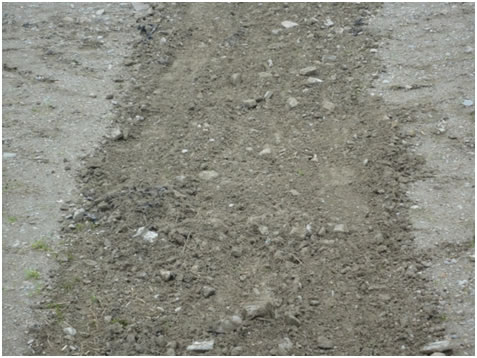 |
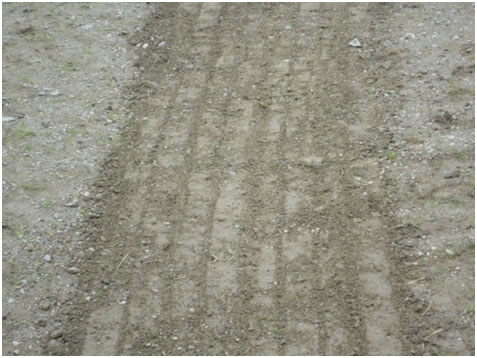 |
Finally the two tracks side by side with the N-Virodredge™ on left;
 |
 |
The difference in the damage to the ground was significant with the traditional dredge digging to a depth of 4cm and then ‘harrowing’ behind. The N-Virodredge™ showed only 9 thin lines of a depth of 2 cm and no ‘harrowing’.
Sea Trials
One N-Virodredge™ was put aboard a scallop vessel. It was fitted in the centre of her towbar with the other nine dredges being traditional. The reason for these trials was to look at catch rates, damage rates to scallops, cleanliness of catch and overall performance.
Catches were counted over one day where 17 hauls were made, from the N-Virodredge™ and the two traditional dredges on each side of it, with the following results;
|
Traditional |
N-Virodredge™ |
Traditional |
| 20 | 31 | 28 |
| 39 | 42 | 36 |
| 40 | 65 | 42 |
| 43 | 57 | 57 |
| 42 | 82 | 42 |
| 22 | 51 | 41 |
| 40 | 43 | 39 |
| 34 | 59 | 42 |
| 45 | 68 | 39 |
| 53 | 75 | 44 |
| 56 | 68 | 39 |
| 73 | 67 | 36 |
| 73 | 67 | 36 |
| 40 | 80 | 60 |
| 63 | 36 | 45 |
| 38 | 49 | 44 |
| 57 | 64 | 51 |
| 50 | 83 | 31 |
| 755 | 1038 | 721 |
As can be seen catch rates for the N-Virodredge™ were significantly higher with the two traditional dredges averaging a total catch of 738 scallops and the N-Virodredge™ 1038 scallops or 300 scallops more or an increase in catch rates of 40%.
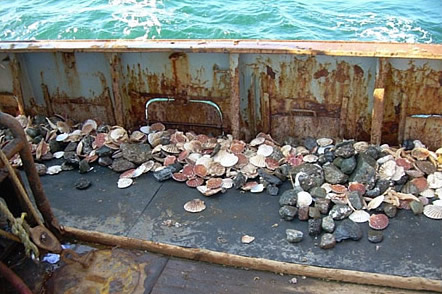 |
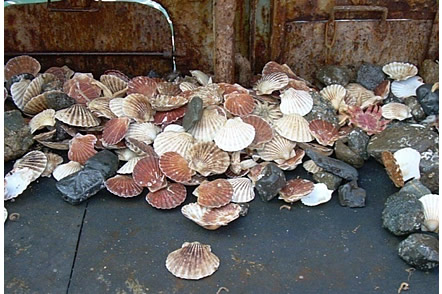 |
As can be seen in the above photos the N-Virodredge™ in the middle caught the scallops very cleanly with very few stones compared with the traditional dredges on either side. This resulted in a count of zero damaged scallops.



